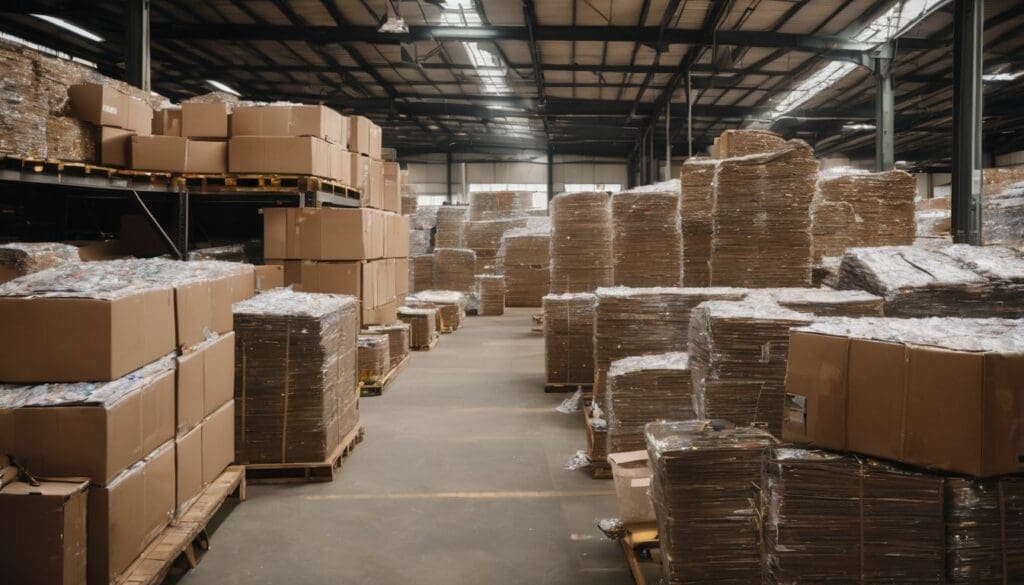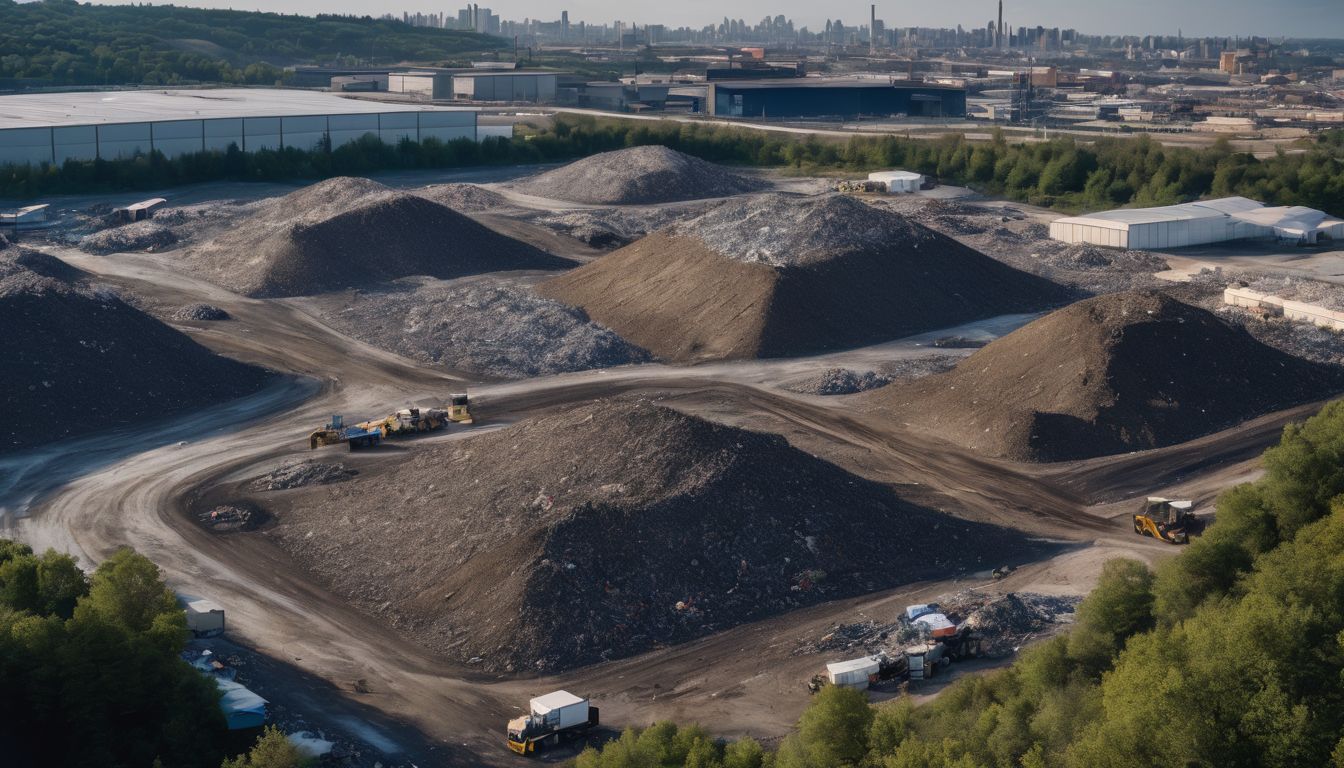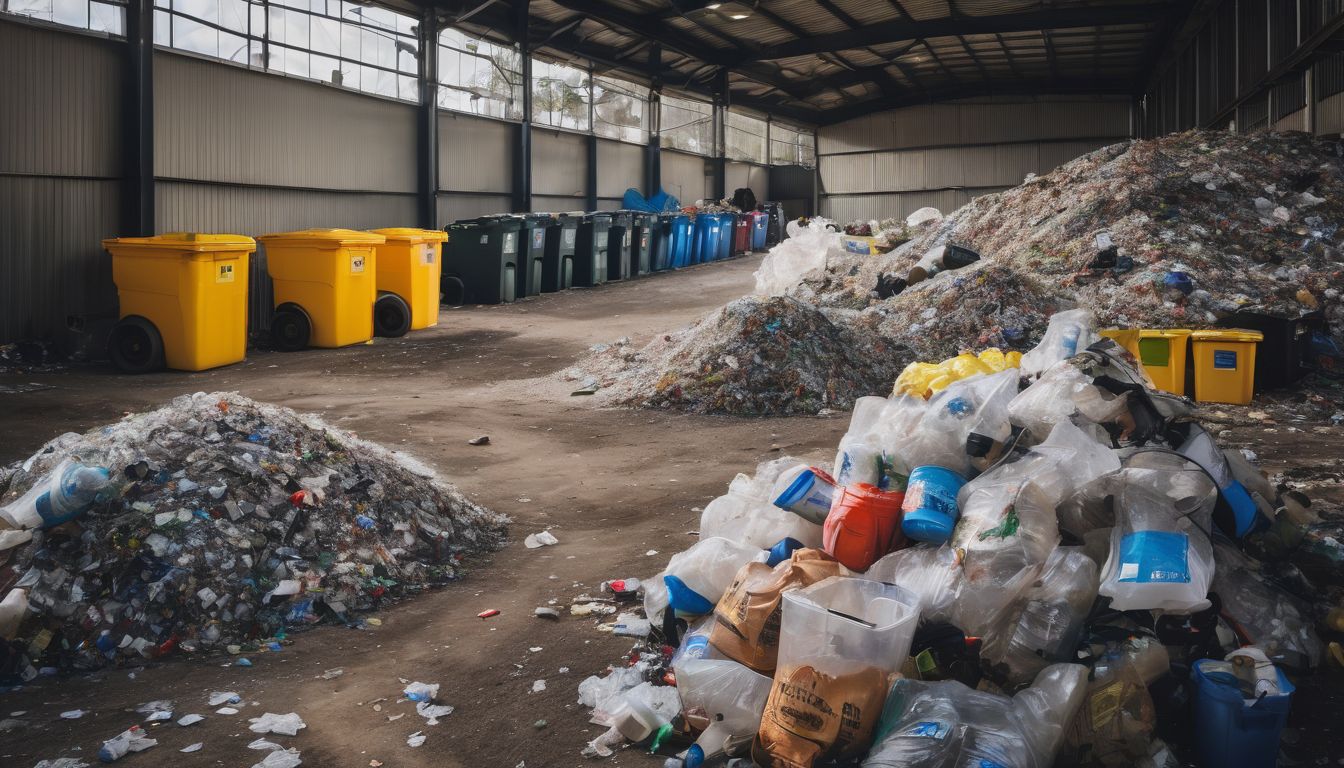Faced with overflowing bins, recycling paper and cardboard can be puzzling. Every year, we use millions of tonnes of these materials in the UK alone. Our guide lays out simple steps to turn waste into eco-friendly treasure.
Dive in for greener habits!
Key Takeaways
- Recycling paper and cardboard saves 17 trees per tonne, reduces energy use by 75%, and cuts carbon emissions.
- Keep recyclables clean – no pizza boxes with food residue or tissues can be recycled. Flatten cardboard to aid the process.
- Recycled materials go to a mill, where they’re turned into new products like newspapers and cereal boxes.
- Use local recycling centres or kerbside pickup for disposing of paper and cardboard responsibly.
- Containment is key: put shredded paper in a clear bag to prevent messes in bins. Choose products made from recycled material.
Why is Paper and Cardboard Recycling Important?
Moving on from the basics, understanding the significance of paper and cardboard recycling is crucial in underpinning our environmental conservation efforts. Every tonne of recycled paper saves approximately 17 trees, underscoring its impact in preserving natural resources and biodiversity.
Paper and cardboard are among the most commonly used materials in daily life – they package our goods, hold our morning coffee, and carry our written communications. Their omnipresence makes it vital to manage this waste stream effectively to prevent overflowing landfills.
Recycling these materials not only conserves forests but also reduces energy use and carbon emissions associated with producing new paper products. For instance, recycled cardboard uses 75% less energy compared to manufacturing from raw materials.
Additionally, as part of sustainable living practices, participating in eco-friendly disposal helps maintain a cleaner environment by minimising pollution that could otherwise arise from waste incineration or decomposition at dumpsites.
Recycling turns old products into new possibilities without depleting further resources – a key step towards responsible waste management and creating a circular economy where nothing goes to waste.
How to Properly Recycle Paper and Cardboard
To properly recycle paper and cardboard, start by separating cardboard from other paper materials. Remember to break down and flatten cardboard boxes before placing them in the recycling bin.
It’s also important to know what types of paper and cardboard can be recycled in your area.
Separate cardboard from other paper
Start by separating cardboard from other paper to ensure the recycling process runs smoothly. Flatten and break down your cardboard boxes before placing them in a separate recycling bin or designated area.
This helps recycling centers efficiently process the materials and prevents contamination of other paper products. Knowing this small detail can make a big impact on the overall success of the recycling process.
Next, let’s explore how to properly recycle different types of paper and cardboard.
Break down and flatten cardboard boxes
To recycle cardboard efficiently, you should break down and flatten cardboard boxes before placing them in the recycling bin. This helps to save space in the recycling container and makes it easier for collectors to transport the cardboard to the recycling facility.
By flattening the boxes, you are also preventing unnecessary waste of valuable space in landfills, contributing to a more sustainable environment.
Knowing how to properly handle your cardboard waste is crucial for effective recycling. The next step after breaking down and flattening your cardboard is understanding what types of paper and cardboard can be recycled.
Know what types of paper and cardboard can be recycled
Paper and cardboard that can be recycled include newspapers, magazines, office paper, cardboard boxes, cereal boxes, and corrugated cardboard. However, it’s important to note that soiled or contaminated paper and cardboard cannot be recycled.
This includes items with food residue like pizza boxes, as well as kitchen roll and tissues. It’s crucial to ensure that the paper and cardboard being recycled are clean in order to prevent contamination of the recycling stream.
By being mindful of the types of paper and cardboard that can be recycled, individuals can significantly contribute to waste reduction efforts and environmental conservation.
In addition to standard paper products like newspapers and magazines, envelopes (with windows removed), telephone directories, greeting cards (without glitter or embellishments), printer paper (without wax coating) are also recyclable materials accepted by most recycling facilities.
What Happens to Recycled Paper and Cardboard?
Recycled paper and cardboard are baled and transported to a recycling mill, where they are processed into new paper and cardboard products. Learn more about the recycling process by reading on!
Baling and transportation to a recycling mill
After the paper and cardboard have been sorted and processed, they are compacted into bales for easier transportation to a recycling mill. These bales are securely bound together using wire or plastic straps, ready to be loaded onto trucks for delivery.
The transportation process ensures that large quantities of recyclable paper and cardboard can be efficiently moved from collection points to the recycling mill, where they will undergo further processing.
Once at the recycling mill, the baled paper and cardboard are unloaded, inspected for any contaminants missed during sorting, and then fed into pulping machines. Here, the materials are mixed with water to create a slurry which is then refined to remove impurities such as ink or adhesives.
Processing into new paper and cardboard products
Recycled paper and cardboard are taken to a recycling mill for baling and transportation. At the recycling mill, the materials undergo processing to remove contaminants. They are then mixed with water to create pulp, which is refined and cleaned.
The pulp is processed into new paper and cardboard products such as newspapers, cereal boxes, and office papers.
The recycled products retain their quality while reducing the need for virgin materials. Additionally, this process conserves resources and energy, making it an environmentally friendly choice for individuals supporting conservation efforts.
Where to Recycle Paper and Cardboard
Find your nearest recycling center or check if there’s a curbside pickup service available in your area. To learn more about effective paper and cardboard recycling, keep reading this guide.
Recycling centers
Recycling centres are essential for paper and cardboard disposal. These facilities accept various types of paper and cardboard waste, ensuring proper recycling. At these locations, individuals can drop off their recyclables in dedicated bins or containers, where they will be collected and sent to reprocessing facilities.
Recycling centres play a crucial role in diverting paper and cardboard from landfills, contributing to environmental sustainability.
These centres also provide a convenient option for those who may not have access to curbside pickup services or live in areas without designated recycling programmes. By utilising recycling centres, individuals actively participate in the responsible management of paper and cardboard waste while promoting eco-friendly practices within their communities.
Curbside pickup
Curbside pickup services make paper and cardboard recycling convenient for households. Residents can simply place their sorted paper and cardboard waste into the designated bin, which will be collected by the recycling service provider.
This eliminates the need for individuals to transport their recyclables to a specific drop-off location, reducing the carbon footprint associated with recycling.
Having an efficient curbside pickup programme encourages more people to participate in paper and cardboard recycling, providing a simple yet impactful way to contribute towards environmental conservation efforts.
It ensures that these materials are diverted from landfills and instead put through the proper channels of reprocessing.
Tips for Effective Paper and Cardboard Recycling
Avoid contamination by removing any non-recyclable materials, recycle shredded paper properly and consider using recycled paper products to reduce your environmental impact. Ready to learn more about sustainable cardboard and paper recycling? Keep reading!
Avoid contamination
Prevent contamination by keeping paper and cardboard clean and dry. Food residues, liquid spills, or greasy substances can spoil the recycling process. Rinse containers and wipe off any food remnants before recycling them.
For shredded paper, ensure that it’s contained in a paper bag to avoid dispersing bits throughout the collection bin.
To reduce contamination, refrain from mixing non-recyclable materials with paper and cardboard waste. Keep items such as plastic bags, rubber bands, or metal clips out of your recyclables.
Recycle shredded paper properly
To recycle shredded paper properly, ensure that it is contained in a clear plastic bag before placing it in the recycling bin. This helps prevent potential mess and contamination during transportation and processing at the recycling facility.
By securely containing shredded paper, you contribute to maintaining the quality of recycled materials and support eco-friendly waste management practices. Shredded paper can then be effectively processed with other recyclable papers to create new sustainable products.
Remember that cardboard can also be broken down into flat pieces for effective recycling.
Consider using recycled paper products
After properly recycling shredded paper, you can take the next step by considering using recycled paper products. By choosing these items, you actively support environmentally friendly cardboard and paper recycling options.
This helps reduce the demand for new paper production and lowers the consumption of natural resources.
When looking for recycled paper products, check for labels indicating post-consumer content or look out for certification from recognised eco-friendly organisations. Many everyday items like stationery, toilet tissue, and packaging materials now have viable recycled alternatives that are widely available in stores and online.
Conclusion
In conclusion, paper and cardboard recycling is crucial for environmental conservation. It helps reduce the amount of waste going to landfills and conserves natural resources by promoting the reuse of materials.
By following the proper guidelines for recycling paper and cardboard, individuals can actively contribute to a sustainable future for our planet. Embracing these practices will lead to a more eco-friendly approach to paper and cardboard waste management.
FAQs
1. What should I do with my paper and cardboard for recycling?
Place your paper and cardboard in the designated recycling bins, ensuring they’re clean and dry, to aid the recycling process at a cardboard recycling centre.
2. Can all types of paper and cardboard materials be recycled?
Most types of paper and cardboard can be recycled through ecofriendly disposal methods, but check with your local collection service or guidelines for specific items allowed in your area’s program.
3. Is there any preparation needed before I put my cardboard into a recycling bin?
Yes, flatten your boxes to save space in the bin; remove any non-cardboard elements like plastic or polystyrene inserts from the materials to ensure correct reprocessing at the facility.
4. How does proper paper and cardboard waste management benefit us?
Properly managing our paper and cardboard waste helps reduce environmental impact, conserves resources by allowing these materials to be reused, supporting sustainable practices within our communities.





